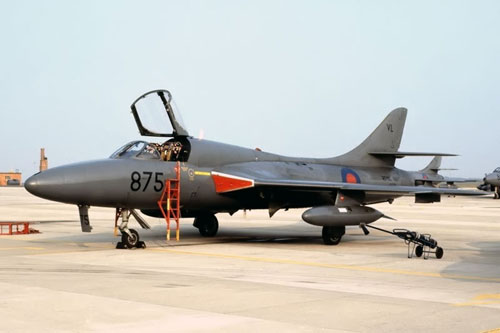Starting Up
For the uninitiated, engine start can be startling. The first versions of
the Hunter were fired off with large brass cartridges filled with cordite. When the
cartridge is ignited, air pressure spools the compressor up to the required speed for a
light-off. The four-second "swoosh" this produces usually sends anyone
within earshot diving for cover, and the plume of black cordite smoke shooting from the
belly sends ramp personnel scrambling for fire extinguishers. Because of the pyrotechnic
danger of the cartridges and their dwindling availability, many owners are converting to
electric starting systems.Cockpit layout is
rather disorganized, even for a jet designed at the beginning of the turbine era. Seems
like the ergonomics engineers at Hawker grabbed a handful of instruments, levers, switches
and dials, threw them up in the air and left them wherever they fell in the cockpit.
Getting Airborne
Asked about the Hunter's flying qualities, former Hawker Chief Test Pilot Bill
Bedford said simply, "It's a real pilot's airplane!" Another example of typical
British understatement.
On takeoff, the Hunter lifts off very naturally and in
flight, its controls are light and well-balanced through the entire range of airspeeds.
Performance-wise, it behaves as well at 600 knots as it does in the traffic pattern, a
claim most jets can't make. Even with the smaller Rolls-Royce Mk.120 engine, there is
impressive acceleration when you need it. The Hunter is such a thoroughbred, it's almost
impossible to fly somewhere straight and level. Aileron rolls are so effortless, they can
become hypnotic. The Hunter's stall and spin characteristics are relatively docile and
predictable. That's why it's the only swept-wing jet in the world routinely used for
spin-recovery training. The wide-track landing gear adds a margin of safety for takeoffs
and landings in crosswinds and on rough surfaces. If the gear won't extend, the Hunter can
land on its underwing fuel tanks with minimal damage.
Airshows and Odd Jobs
N289XF has performed at some of the country's biggest airshows, including Oshkosh
and the USAF 50th anniversary at Edwards AFB in 1997. Last year, I flew to several shows
with George Lazik and his Polish Air Force MiG-17. We usually depart Van Nuys [California]
as a two-ship, climb to flight level 20- or 30- something and arrive at the destination
with an overhead break. Not even in my dreams did I ever think I'd one day be flying a
Hawker Hunter in formation with a Soviet MiG. Tearing along at 450 knots next to a MiG
with rocket pods under its wings is one of the highlights of my 20-year flying career.
N289XF's career as a civil jet hasn't been all play and no
work, however. The Air Force Test Pilot School at Edwards AFB and the National Test Pilot
School at Mojave, Calif. both leased the swept-wing Hunter to teach pilots
about the handling
characteristics of early Fifties fighters. It even flew the role of "Goon 51"
with the former Top Gun school at the Naval Strike and Air Warfare Center (NSAWC), NAS
Fallon, Nevada. Along with several other vintage jets, N289XF was invited to fly against
recent NSAWC graduates as a "surprise adversary."
Civil Versus Military
Like many Hunter T.8Cs, N289XF began life as a single-seat F.4 variant. In 1958,
Hawker converted it to a two-seat T.7 and shortly thereafter, converted it again to a T.8
for the Royal Navy's Number 764 Squadron. After many years of service, it was transferred
to the Fleet Requirements and Direction Unit at RNAS Yeovilton in the mid-1980s. The
airplane was used for Harrier conversion training and as a low-level target simulator
until it was sold at auction in November 1994.
There are some major differences between how the Hunter is
flown on the civilian airshow circuit and how they were operated by the military, and most
of them have to do with economics. It's not news that jet warbirds are ungodly expensive
to operate when a private citizen rather than a government is paying the bills. In the
military, a jet's wings were routinely loaded with as many weapons as possible; for
airshow flying, we carry as many fuel tanks as possible. That's because when a show is
providing free fuel, you want to be able to take as much as you possibly can. It's the
same with brakes. A civilian pilot uses aerodynamic braking and as much of the runway as
he can to prolong the life of hard-to-find brakes. Where military pilots flew the Hunter
in all kinds of instrument conditions, we try to fly VFR whenever possible.
Maintaining the Hunter hasn't been a problem so far. However,
it's obvious that some necessities will soon be in short supply and require extensive and
expensive searching to obtain. Among these are start cartridges, isopropyl nitrate used to
start the bigger engines, brake disks and pads. Guilford said that he and others are
researching the possibility of re-chroming the disks and having the pads manufactured
abroad from scratch. * * * * *
Article Copyright 2003 Vince Moore,
All Rights Reserved. Used with permission. |

